Somewhere between truth and illusion, you will find the land Underneath Which Rivers Flow. As part of Performatik, Globe Aroma and Jozef Wouters’s Decoratelier are organizing guided voyages through their secret garden there. A trip through the wormholes in their built and unbuilt park.
© Wannes Cre
| Globe Aroma & Decoratelier: Underneath Which Rivers Flow
It begins. We think. We’ve never experienced this before: the beginning of everything. And everything is mist. A few lights appear, here and there, exploring the fog-enveloped space. Slowly, quickening, curiously faltering. Two comets fly past, narrowly missing each other, while the gaseous lights seep in from the sides of this space. A bicycle creaks past in between us. A cogwheel comes our way, globes emerge. We smell coffee, as the music swells.
A young voice leads us reassuringly through the dark night, which is filled with imagination at a dizzying speed. Crossroads, a kind of giraffe, a Maserati, a smiley? It is Monday evening, 4 March and here, in an old factory in Molenbeek, the firmament appears to take shape before our very eyes. As the mist slowly rises, we ourselves are set in motion, and at the end of a winding path, we find ourselves in a swirling circle of packed bodies that laughingly try to catch the light.
It is a planet to itself, we think the next day, in one of the barely heated spaces in the enormous building on Liverpoolstraat/rue Liverpool where the Decoratelier is based. Jozef Wouters, scenographer-artist and independent artist-in-residence at Damaged Goods, Meg Stuart’s dance company, established a year-long dialogue here with an incredibly diverse group of refugees, newcomer-artists, and locals from the open arts centre Globe Aroma. “The initial question was very simple: is it possible to build something together as a group without knowing what you are going to build beforehand?” Jozef Wouters explains how the dialogue germinated. “Building out loud,” is what he calls it. “So that there is no longer a difference between building and speaking. So that the construction itself is the dialogue.”
Where is all the architecture that is not built, that is not ‘realistic’ or sustainable? I want to be able to see that other city, where projects don’t have to be real
When we walk through the space again where the night before, thick mist obscured a gigantic Bialetti espresso machine, a fragile boat, and a number of (literally) dreamed-up constructions, we understand what he means. Like the Big Bang, this project created a void. A space as a bland sheet bursting with possibility. A translation error – a space or (just) space? – allowed cosmic metaphors to creep in. “I hadn’t anticipated those, no. That is the kind of thing that happens when you open everything up and try to take every suggestion seriously. (Laughs) Apparently, when faced with an empty space, a common imagination ignites that automatically reaches to the cosmos to generate new metaphors to talk about a group and a space.”
HESITATION AND SURRENDER
These spatial peregrinations make the universe, which is being presented at Performatik, expand. It reveals and conceals, drifts between visible and invisible. And in doing so, drops anchors to the ground beneath our feet. Underneath Which Rivers Flow refers concretely to the Canal Plan which will radically overhaul the area around the canal, adding a park in the Heyvaert Quarter where the Decoratelier now stands. During Performatik, a different park will be shown, “in which memory and imagination merge.” “A secret garden”, “full of wormholes to unsuspected worlds.” “Like a sort of pre-enactment,” Jozef Wouters says. “Within six months, this building will be demolished and a park will be built here, according to the regulations enforced in this area: gated, with a superintendent living on the corner so that he can see across the whole park, lighting, not too many bushes… The architecture of the future park is based on the idea that nothing may remain unseen. I understand why you couldn’t build a labyrinth here, but this demand for total transparency is completely contrary to nineteenth-century park designs. Back then, people still thought that cities needed secrets; parks in which they could walk around visibly, but also disappear if they wanted to.”
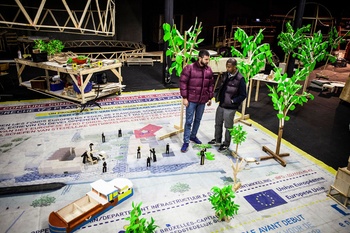
© Karen Vandenberghe
| Globe Aroma & Decoratelier: Underneath Which Rivers Flow
This is very clear from the story of Idris Hassan Hardi, a newcomer who works at Globe Aroma as a volunteer and who joined the project after some preliminary exploration. “Idris stayed somewhat outside the group at the beginning of the project,” Jozef Wouters says. “You introduced yourself…” “And I said: ‘I’ll have to see if I can stay’,” Idris Hassan Hardi responds. “And yesterday evening, during rehearsals, you stood in the centre of the large circle of bodies and were completely lost in the moment,” Jozef Wouters laughs. “That shift, from hesitation to complete surrender, was brilliant.”
“I kept coming back,” Idris Hassan Hardi explains, “because I have always loved working with wood. There was a lot of available material here and there was a lot to learn.” The maths teacher from Djibouti, a small country on the Horn of Africa, has since been regularized and knows the significance of the demand for transparency. “As a newcomer you have to justify yourself constantly and prove your worth. You have to reveal everything about your past and your whole life is carefully checked and sifted. I lived at the Klein Kasteeltje/Petit-Château, in a small room without a door or sound insulation, one of twelve on my corridor. You are stripped of all your rights in centres like that: you sleep when you are told to sleep, you eat when you are told to eat… What really appealed to me about coming back to the studio was the freedom. You come in here with your own ideas, you are given the materials to implement and build them, and the meaning of whatever you make is individual. We then find mutual connections between the projects. It is that freedom that kept me coming back.”
THE RADICAL ILLUSION
A copy of his room in the Klein Kasteeltje/Petit-Château has been erected at the back of the Decoratelier. Crossroads, likewise his own work, evoke the blockading you can experience when your asylum application is processed and your life is put on standby. On the other hand, the boat that he made refers to a sculpture that he made 30 years ago when he was working as the assistant to a carpenter and decided to do something with the refuse wood.
You can write the stories of people who may no longer be here through their buildings, through their art. That’s the purpose of leaving something behind
“This project is about relinquishing control, just letting things come,” Jozef Wouters says. “Perhaps only one percent of people in the city have the right to build something. But where is all the architecture that is not built, that is not ‘realistic’, that is not economically stable or sustainable? I want to be able to see that other city, where projects don’t have to be real. The burden of being real results in gated parks, transparency, police… There are so many things in this project that aren’t even architecture, that are just there. Even when Idris is not here, the things he made are. And we call them Idris: ‘Could you just move Idris over there?’ (Laughs) It is a form of representational building. To me, the essence of scenography lies in allowing somebody’s desire to become space.”
THE ABANDONED POEM
Becoming space, leaving a trace, becoming visible. These are thoughts that recur often during our conversation. “Spoken words fly away, written words remain,” Idris Hassan Hardi says. “You can write the stories of people who may no longer be here through their buildings, through their art. That’s the purpose of leaving something behind. Perhaps something of our secret park will be allowed to stay in the future?”
Jozef Wouters: “From the very beginning of this project, the participants discussed whether there was any use or point to it. Must it influence the future to be successful? Perhaps it is my privilege to be able to say: the temporary is enough. I think that is the real work. For the year that our secret garden is here, the metaphor is the strongest. To me, the energy here, in our planetarium this year, is more important than whatever remains afterwards. The fact that for a whole year, between the two realities of this building – it used to be a factory and in the future it will be a park – a radical illusion was allowed to exist that was real. If you look at this space now, full of our constructions, it makes me want to champion the very real power of a temporary illusion.”
Yesterday evening during the rehearsal, the mist-enveloped voiceover said that in a few billion years, our Milky Way will crash into the Andromeda galaxy. The sun will shift and new constellations will emerge. The collision will pass unnoticed on Earth. If we don’t see it or feel it and can only imagine it, did it really happen? Does it affect us? Does something have to be real to be true? “As the initiator of this project, I had to accept that it is not only the actually constructed things that are part of our park,” Jozef Wouters says. “That is why the towering structure with the blue mats is in the space: The Unbuilt. That will be the name of the school that I want to found next year: The Unbuilt School of Architecture. There are people in our group who due to a lack of time, a lack of skills, or simply because they had thousands of ideas, could not complete everything that they wanted to build. This raises the question: how can this unbuilt architecture still be present in the garden?”
Teaser Underneath Which Rivers Flow
“Mimouna, for example, made a construction that exists solely of words, a dream in a dream in a dream, which was created with WhatsApp. On the other hand, Bushra builds architecture with our bodies. To me, everything in this project, including the tiniest things or the things that are not even constructed, is of the same value. Some of the spaces work better when they are not built. As a result, a fictional main character gradually emerged over the course of the project: the architect who sleeps, and who does not build but dreams about her constructions. Like that line by Enrique Vila-Matas: ‘Poets don’t finish poems, they abandon them.’ That’s it! I dream of an architecture that is as fast as words, as metaphors. In which you can build something simply by saying it.”
OFF THE HINGES
Underneath Which Rivers Flow balances on precisely that pivotal point: the fiction that dreams of reality and reality that catches up to fiction. “Fiction evolves with time,” Idris Hassan Hardi says. “Only a few decades ago, the idea that you could speak to somebody who was not physically present was a fiction, absurd. Today it is a reality. Fiction is an infinite space. You cannot forbid somebody from dreaming. You can’t manipulate dreams. They are elusive and evade all control. Fiction is a dream of the future, a collection of possibilities that you cannot reach now. But perhaps a future generation will.”
“Therein lies the longevity of this project,” Jozef Wouters adds. “How can a metaphor as we have built it here contribute to this city? How can a secret garden feed the debate about public space in Brussels? Various perspectives coalesce here. Sometimes they clash, but they also expand horizons. For example, I grew up with the cliché that an open square signifies democracy. Like the agora in Athens. But if that open space is used to create transparency that is only bearable for part of the population, de facto it is an ideology. I think we must question our notion of public space and seek new forms for contemporary cities. It is important to have an honest conversation about semi-public spaces. Perhaps a first step would be that we don’t keep silent about the gates in our public parks, but that we engage in dialogue about their hinged movement. About how such gates can protect fragile spaces from the dominance of public space as we know it. Because a city still needs secret parks where you can disappear and reappear.”
Underneath Which Rivers Flow
15 > 23/3, Decoratelier
Read more about: Podium , Globe Aroma , Decoratelier , Performatik , Jozef Wouters
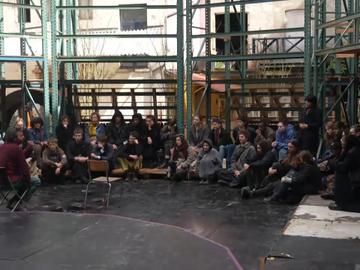
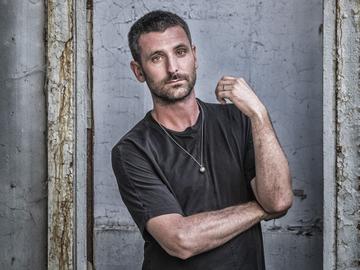
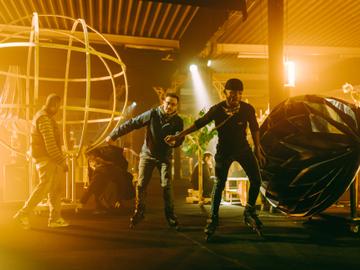
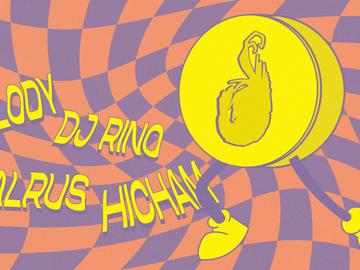
Fijn dat je wil reageren. Wie reageert, gaat akkoord met onze huisregels. Hoe reageren via Disqus? Een woordje uitleg.